* (restored/Halloween countdown post #13)
—-
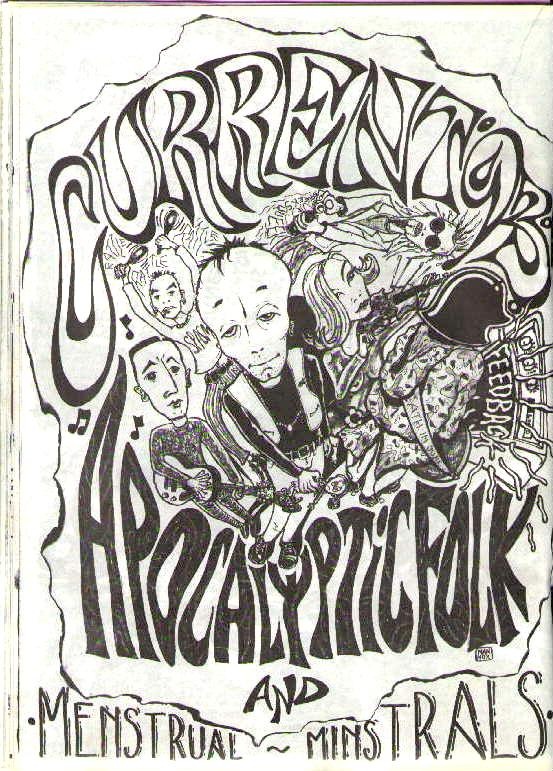
“I think that we’re living in an artifice that’s been created, that perhaps is a dream of Satan, and Christ is continually suffering on the cross at this very moment whilst we’re wandering around in this fog. I refer to it as a Satanic imperium. It’s the Roman Empire continuing with all the wickedness and evil and inhumanity.”
-David Tibet, from an interview with The Wire magazine (July 2006)
Although I can think of so many bands whose music I enjoy, there are only an elite few who I listen to religiously. Current 93 is one such band, and in this case I don’t use the word “religiously” lightly. After all, Current 93 has, since its very inception, been a primarily spiritual band, revolving around, at various points in its constantly mutating lifespan, Crowleyan occultism, Norse paganism, Gnosticism, Tibetan Buddhism, and, above all else, eschatological Christianity. In fact, I would say that Current 93 provides good proof that not all Christian music sucks. But then again, Current 93 could hardly be called a Christian band in the conventional sense. Or even a conventional band, for that matter. In an interview conducted with David Tibet for the July 2006 issue of The Wire magazine, Keith Moline noted that, “To talk to David Tibet about his work is to talk about his religious beliefs; there is no way that his music can be discussed without reference to the apocalyptic vision and deep moral conviction underpinning it.”
Current 93 is pretty much the brainchild of one man: David Tibet. Indeed, Tibet is the only member of Current 93 who has appeared on every one of the group’s many, many albums. The musicians who accompany him are an ever-changing Teatro Grottesco: the only constant member has been Nurse With Wound’s Steven Stapleton, who has appeared on most (but not all) of Current 93’s albums. Other contributors have included guitarists such as Death In June’s Douglas Pearce and, more recently, Michael Cashmore, bassists like Tony Wakeford (Death In June again), and a large cast of guest singers, including Crass’ Steve Ignorant, NON’s Boyd Rice, Coil’s John Balance, the runologist Freya Aswynn, Nick Cave, Björk, Mark Almond, Rose McDowall, Antony Hegarty, Annie Anxiety, Tiny Tim, Rickie Lee Jones, and Shirley Collins. Even the American horror writer Thomas Ligotti was at one point a member of the Current.
With such an eclectic group of performers, one would expect Current 93 to be a very experimental listening experience, and such an assumption is correct. It’s hard to classify Current 93’s sound, as it has shifted so often throughout the years. “Apocalyptic Folk” is one label that has been attached to the group over the years, though Tibet has stated that this has less to do with folk as a musical genre and more to do with the fact that the people who make up Current 93 are apocalyptic folk. On Current 93’s MySpace page, the band is classified as “Glam/ Psychedelic/ Christian”, while on David Tibet’s MySpace page he describes Current 93 as sounding like: “Black Ships Eating The Sky/ Good-ol’ time Armageddon Music/Lazarus Arising/Words of Romans creeping in/Torture in the Toy-box/Infernal and Eternal Rome.” Or, for those who prefer a less abstract description, consider Tibet’s explanation of the themes of Current 93, as written in the liner notes to the collection of greatest hits known as Calling For Vanished Faces: “apocalypse in the great and the small- the human and the universal; our loss of humanity and innocence; the centrality of Christ as the great mystery and the great question that must be answered; love, silence, sleep, and where dreams go to when they die.”
Despite the fact that Current 93’s sound has changed quite often over the years, one thing that hasn’t changed is the themes that Tibet explores. These include Christ, Christian Mysticism, the Apocalypse, cats, Tibetan Buddhism, runes, and, perhaps more than anything else, dreams, time and death. Current 93 acts as a mirror for Tibet’s ever evolving obsessions: Maldoror, the Bible, Gnostic texts such as “The Thunder Perfect Mind,” writers of the supernatural such as Ligotti, Arthur Machen, and MR James, the bizarre cat art of Louis Wain, William Blake, The Cloud of Unknowing, and so forth. Part of the reason why I enjoy the music of Current 93 so much is because it has exposed me to so many other writers, artists and musicians that I probably would never have heard about in the first place. To listen to a Current 93 album is to enter into a totally different world of macabre nursery rhymes and sinister folk songs, Biblical prophecy and hypnagogic visions, playful cats and monstrous shadows, a dimension both horrifying and beautiful. The closest comparison I can make to it in literature would be, unsurprisingly, the short stories of Thomas Ligotti. As Antony from Antony and the Johnsons writes about David Tibet, “He breathes in a box of shadows and exhales a poem.”
For the curious, a full list of Current 93’s influences may be found at the following website: http://brainwashed.com/c93/misc.php?site=c93.

There are many things I enjoy about Current 93, from the often surrealistic album artwork (usually provided either by Stapleton or Tibet), the joy of deciphering the sometimes cryptic lyrics and liner notes, and, of course, the music itself. However, to me, it’s David Tibet’s voice that really sells it for me. I think he has an incredible voice, and I rank him up there with some of my other favorite male vocalists, a list that includes Marc Almond, Whitehouse’s William Bennett, Genesis P-Orridge, and, more recently, Adam Lambert.
I’m not exactly sure when it was that I first heard about Current 93, but it was probably sometime in the year 2000, a period of my life when I was an obsessive Throbbing Gristle fan and was just beginning to explore a lot of the music associated with the British industrial music scene that began in the mid to late 1970’s and truly blossomed in the early to mid 1980’s (in my opinion, one of the best periods of music ever). It was around the year 2001 or so when I purchased a book called Tape Delay: Confessions from the Eighties Underground by Charles Neal (published by SAF Publishing in the year 1987, reprinted in 2001). This book features an incredible amount of interviews by such alternative musical luminaries as Nick Cave, New Order, Sonic Youth, The Fall, Coil, Matt Johnson, Cabaret Voltaire, Genesis P-Orridge/Psychic TV, Swans, Chris & Cosey, Foetus, Einsturzende Neubauten, Henry Rollins, Lydia Lunch, Marc Almond, The Hafler Trio, Boyd Rice, Test Dept, Diamanda Galas, Laibach, and, of course, Current 93. I highly recommend this book, as it’s a virtual who’s who of the underground music scene of the 1980’s (although Whitehouse and Nurse With Wound should have been featured also, in my opinion). I found that it was the interview with David Tibet that fascinated me the most. I’m not sure when this interview took place but I’ll guess and say sometime in 1984, as it mentions the first Current 93 album (Nature Unveiled) but not the second. Charles Neal summarized the music of Current 93 thusly:
“Recurring themes in the work of Current 93 include religion, magic, history and ritual. Through tape loops and minimal instrumentation, the group conjures up images of beauty and horror simultaneously. Whereas the melody carried throughout is often as soothing as a chant, the interaction between electronic effects and David Tibet’s possessed cry- feeds the listener various visions. These might include a peek inside the catacombs where spirits, often surreptitious, have now plotted for an out and out attack on the other side, or a journey into the mind of a little girl- becoming closer to the outside world which will eventually enlighten her or take away her inherent innocence. Throughout their records, one thing remains constant: The atmospheres created by Current 93 transform and breed many responses, allowing themselves to be interpreted to varying degrees.”
The interview itself is very interesting to read. In it, Tibet discusses the significance behind the group name Current 93, the reasons why he lost interest in Crowley and the occult, the ideas and motivations that inspired his first album, his thoughts on the uses of frequencies and subliminals on albums, the ritual instrument known as the Tibetan thighbone, his stance on religion (“Religion; it’s just a pile of shit, isn’t it?”) and Satanism (“Satanists are just childish people”), and it concludes with a passage that he claimed best summed up everything that the Current manifests: “The sound of the bell of Gionshyn echoes the impermanence of all things. The hue of the flowers of the teak tree declares that they who flourish must be brought low. Yea, the proud ones are but for the moment, like an evening dream in Springtime. The mighty are destroyed at the last, they are dust before the wind.”
For the curious, that’s the opening passage of The Tale of the Heiki, and it reflects the Buddhist law of impermanence.
Most interesting of all to me were some of the books that Tibet named as influences, such as Lautreamont’s Maldoror, which he claimed was his favorite book (well, at that time period). The shadow of Maldoror looms large over Current 93’s body of work, especially in the early albums. I had never heard of Maldoror at that time but from the way Tibet described it, I knew I had to get it (though I didn’t actually end up buying and reading it until sometime in 2004): “In terms of darkness and humour, it just seems to encapsulate everything; it doesn’t take itself too seriously but at the same time it has got this intense terror or complete hopelessness that permeates- atmospheres that I like to wallow in I suppose.” He also mentions his interest in conspiracy theories and general plots revolving around the apocalypse and the Anti-Christ legend, and how he owned a book about the Anti-Christ in the middle ages which was his favorite after Maldoror: however, he does not name this book. For many years, I tried to figure out what book he was referring to, and in 2007 I came to the conclusion that it was Antichrist in the Middle Ages: A Study of Medieval Apocalypticism, Art, and Literature (written by Prof. Richard K. Emmerson, published by the University of Washington Press in 1981… Another book I highly recommend).
My next exposure to Current 93 came in the summer of 2001, a few months after I read the aforementioned interview in Tape Delay. That summer I purchased the All Music Guide to Electronica, and in this book they had an entry where they reviewed the first two Current 93 albums (what Current 93 was doing in a guide to electronica music is anyone’s guess). In those days I would often spend long periods of time reading album reviews, then seeking out the albums whose reviews I found to be the most interesting. The All Music Guide gave Current 93’s second album, Dogs Blood Rising, a four star score, and this was the review by Ned Raggett (which I include here because it’s what inspired me to really seek out Current 93):
“Having established his art on initial releases, Tibet makes a stunning declaration of purpose on Dogs Blood Rising, one of the most frightening, nerve-wracking records ever released. Interspersing quicker tracks and two lengthy evocations of destruction, Dogs Blood shows Tibet and his collaborators — including, as always, Stapleton — combining everything from invocations of Yukio Mishima to Christianity in a harrowing blend. Opening track “Christus Christus” sets the tone with its heavily flanged and looped vocals, chanting the title over and over again against a wash of sound, but it’s the following track, “Falling Back in Fields of Rape,” which truly begins to set this album apart. With guest vocals courtesy of Crass singer Steve Ignorant, who recites lyrics clearly meant to play on both senses of the word “rape,” everything — from recurrent chants of “War!”, other choral moans, varying percussion, heavily treated musical snippets, and fragment loops — builds and fades throughout the mix. When a young girl’s voice takes over the main lyrics after a snippet of a nursery rhyme is sung, the sheer sense of creep out grows even higher. It’s even further intensified as Ignorant’s rasping shouts of the main lyric start floating up through the mix like a mantra from hell. “From Broken Cross, Locusts” provides a semi-respite in ways, but only just, chanting from Tibet and others floating low in the mix as a recurrent, strange drum loop sets the overall pace before a sudden, frazzled ending. “Raio No Terrasu (Jesus Wept)” ratchets up everything to the level of apocalypse — the music doesn’t pound and explode, but the ever-more pained, wailed voices chanting the title phrase or other similarly disturbed lines, or simply calling and keening unintelligibly, become a disturbing, fractured and tape-treated collage of sound. “St. Peters Keys All Bloody” concludes the album on a perversely calm note, with Tibet speaking in a snarl, then softly singing “The Sounds of Silence” and “Scarborough Fair” by Simon & Garfunkel. It’s a chilling coda to a striking album.”
Upon reading that review, I knew that I had to explore the music of Current 93. However, none of the CD stores where I lived ever seemed to have any of their albums (I ran into this same problem with groups like Throbbing Gristle, Whitehouse, and Nurse With Wound, incidentally).
Fast forward to Spring 2002, a couple of months later. In late April of that year, the gay/straight/bi/trans student group that I was a member of at Rhode Island College paid a visit to UMASS-Amherst, to attend that year’s Infinite Revolution: The Northeast GLBTQA Student Conference. It was a three day event, beginning on Friday, April 26 and ending on Sunday, April 28. But the key date was Saturday, April 27. A dance was scheduled that evening in one of the campus ballrooms. Prior to that event, my friends and I took a bus into the town of Amherst, to go look for something to eat. Once in town, we all split up, as some people wanted Chinese, some wanted Thai, whereas I was just looking for a place that sold hamburgers and French fries. Before I ate, I popped into the Newbury Comics CD store located at 50 Main Street. This Newbury Comics was slightly different than other stores I had been to in that chain, in that it was long and narrow, somewhat cramped. But it was there that I first saw it: Current 93’s Dogs Blood Rising, the album I had been searching for for months. This particular version was the 1995 reissue (as it had previously been released in CD format in 1988). I promptly purchased it, but was unable to listen to it until I got home that Sunday, as I had neglected to bring a music player on the trip with me.
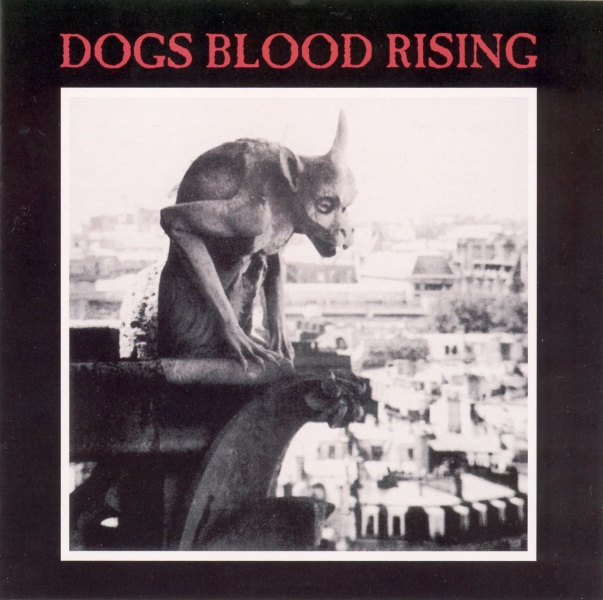
My first impressions were favorable: the front artwork alone, a simple black and white photograph of a horned gargoyle perched atop Notre Dame Cathedral, was very striking, and the six song titles listed on back seemed very mysterious and evocative to me. I also liked the art on the back, an image of a horned demon whispering into the ears of a bearded man wearing a robe. At first I assumed that this bearded man was Christ, being tempted in the wilderness by the Devil. However, upon reading the liner notes that Sunday, I found out it was actually a detail from Luca Signorelli’s Rule of AntiChrist (1499-1504). I should probably say something here about how crazy I was (and still am) for the liner notes inside the CD booklet itself. After five pages of lyrics, the sixth page is the actual album credits, and like the liner notes that accompanied the CD booklet to Coil’s Scatology I found these notes to be just as mysterious and cryptic. First off, they begin with this odd phrase: “We see the decay of the angel the march to the end is in order human life is limited.” And this is followed by a list of people who worked on the album: “93 Current 93 in 1984 we then arose as dogs over carrion: Tibet 93; Steven Stapleton; John Murphy; Nicholas Rogers; Crystale Belle Scrodd; Steven Ignorant; Isidore Ducasse; Igs; Tathata Louise Aisling; Christ 777. They, alas, have returned as a dog to his vomit. Thanks to Douglas P. who was already amongst us, and to John Balance.” Some of these names, such as David Tibet and Steven Stapleton, were familiar to me, but I wondered who this “Igs” fellow was, to say nothing of “Christ 777” and “Isidore Ducasse” (which I later would find out was just an in-joke on Tibet’s part). After the mention of Signorelli, there is the phrase “He is near, at the door” which also puzzled me. I would later find out it was also related to the Antichrist. Then there were weird Latin phrases such as O tempora, o mores. Current 93 itself was identified as “Very Voice Of Very God,” and at the end of the distribution information, the liner notes read “Thank You Three; not part of the Satanic conspiracy.”
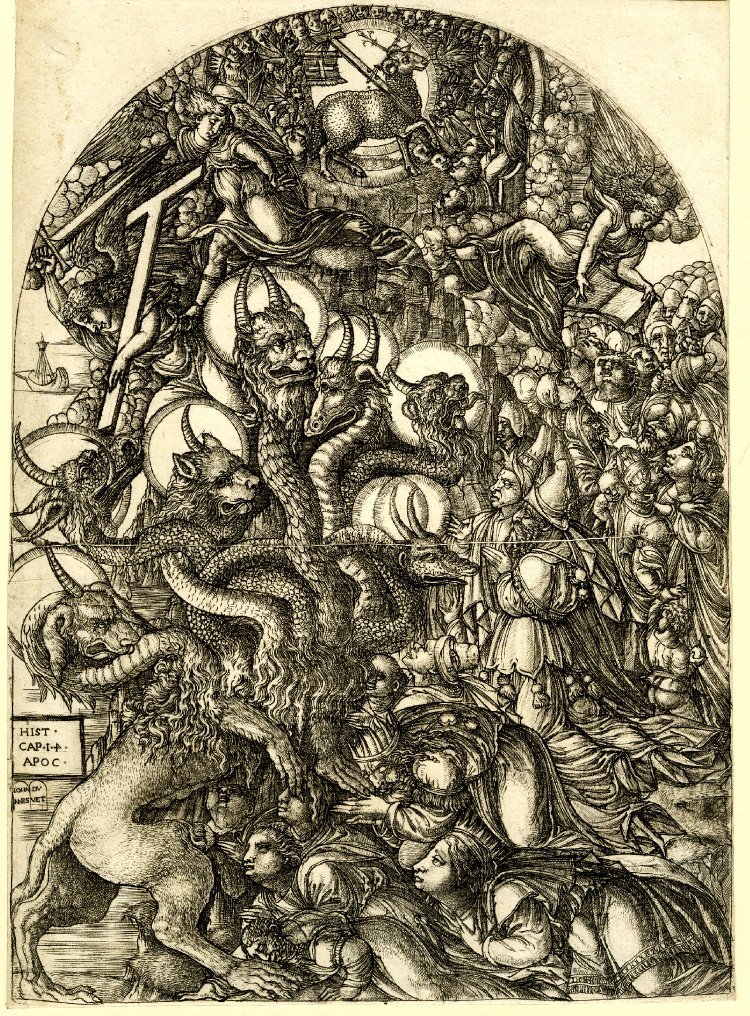
I was also obsessed with the art that adorned the pages of this booklet. For many years, I tried in vain to identify the work of art and the artist, and then, in late 2008, I finally found my answer: the art was engravings from Jean Duvet’s 16th century Apocalypse series, in particular plate #14, “The Worship of the Seven-Headed Beast,” done in red and black colors. Another mystery solved!
And so I began collecting Current 93 albums. It was around this point that CD stores in my area would stock one or two of them every now and then, so I slowly built up my collection. At first, it was a daunting task, as Current 93 is one of those bands (like Nurse With Wound and The Residents) who have formidable discographies. After all, the band has released around 20 or so major studio albums, plus a large number of singles, EPs, live albums, three greatest hit collections, even a comic book. The second Current 93 album I got was actually their debut album, Nature Unveiled, and for a few years I stuck to mainly listening to the early Current 93 albums, the ones that were released in the mid 1980’s, back in their darker, more “industrial” period, when a typical album of theirs tended to be two long 20 minute tracks (one track for each side of an LP), said tracks being mainly composed of tape loops, samples of the plainchant of Gregorian monks, electronic noise, Tibet’s voice, and so on. It really wasn’t until 2008 that I became a fanatical fan. That’s when I started to become obsessed with one of their earlier albums, 1987’s Imperium, which I’ll go into further detail about later on. It was around this point that I began listening to the more soothing and folk-like later albums, which I had kind of been neglecting during my initial years of collecting Current 93.
Of course, I realize that I am just one fanatical Current 93 fan among many. And Tibet himself is well-aware of the obsessive nature of his fans. In an interview conducted with Terrorizer magazine he had this to say on the subject: “I am aware of the extreme emotional attachment that people have to it. On one level I haven’t got a clue why anyone would get what I’m talking about, and I don’t mean that in the sense that it’s too profound. But it’s just so, so personal. Music that I love the most is music that moves me, and that sends shivers up my spine.” Still, I doubt many Current 93 fans have written an entire book inspired by Current 93 music like I have… or, for that matter, arranged said book’s acknowledgments page so that it resembles that of the one in the Dogs Blood Rising CD booklet!
One of the things that interests me most about Current 93 is how the albums, when viewed from the first to the last, chronicle David Tibet’s spiritual life journey. It’s the kind of thing that probably wouldn‘t interest atheists a whole lot, but this kind of spiritual narrative has always been a fascination of mine, perhaps because of my own ever-evolving spiritual tastes. As Tibet himself states, “Lyrically and thematically, Current 93 is a way of me working out my own salvation.” Starting from the earliest Current 93 albums and going to more recent ones, we can see how Tibet’s tastes change: from Aleister Crowley and Typhonian occultism (LAShTAL) to a sort of confused diabolism (Nature Unveiled and Dogs Blood Rising), Germanic paganism (Swastikas for Noddy), Tibetan Buddhism (Imperium), Gnosticism (Thunder Perfect Mind) to Christian mysticism (Of Ruine or Some Blazing Starre) and so on. The only constant in all this is Tibet’s obsession with Christianity, which bordered on blasphemy for earlier releases (especially on the single Happy Birthday, Pigface Christus) yet gradually became more pious.
In some ways, Tibet strikes me as a very Huysmans-like figure, and I wonder how much of Huysmans’ books he’s actually read (I’ve only come across two interviews where he mentions Huysmans as an influence, but he doesn’t elaborate). The novels of Huysmans, after all, reflect his spiritual path, from the Schopenhauer-influenced nihilism of Down Stream and Against Nature to Satanism and the occult in La-Bas to Christian mysticism and Roman Catholicism of the Durtal religious trilogy. I find it interesting that these two men both really got into their artistic groove in the 80’s of their respective decades (the 1880s for Huysmans and the 1980s for Tibet). Separated by a century, both seem to be products of the Fin de siècle, and even their spiritual paths seem to reflect each other’s as both went through an anti-Christian occult period and both ended up converting to Roman Catholicism. There are, of course, key differences, in that Huysmans became very conservative whereas Tibet, though possessing certain orthodox beliefs, follows a slightly more quirky and personal version of Christianity. Also, one can’t ignore
Tibet’s fascination with Tibetan Buddhism, whereas Huysmans never seemed all that interested in oriental religion. In any event, I don’t find it surprising that around the same time I got super-obsessed in Current 93 (during 2008) was also around the same time I was immersed in Huysmans’ novels. Indeed, the artistry of both of these men profoundly transformed my own viewpoints in regards to Christianity, but I won’t elaborate on that here.
I apologize for this somewhat lengthy introduction. I will now proceed to provide a summary of the lifespan of Current 93, focusing on many of the major events and studio albums (though not all of them: there are too many to go into). This is followed by my thoughts on one particular Current 93 album (Imperium), some Current 93 songs on Youtube, a brief entry on the artwork of David Tibet, some recommended reading, and finally, a few links of interest (sadly, there aren’t exactly a lot of Current 93 websites on the internet). I hope you enjoy reading about Current 93, and I hope this day creates a few converts to their music, in much the same way that my Whitehouse Day did on here a couple of years ago. If you have any questions about Current 93 please don’t hesitate to ask: I could pontificate about them all day, as you have probably deduced by now.
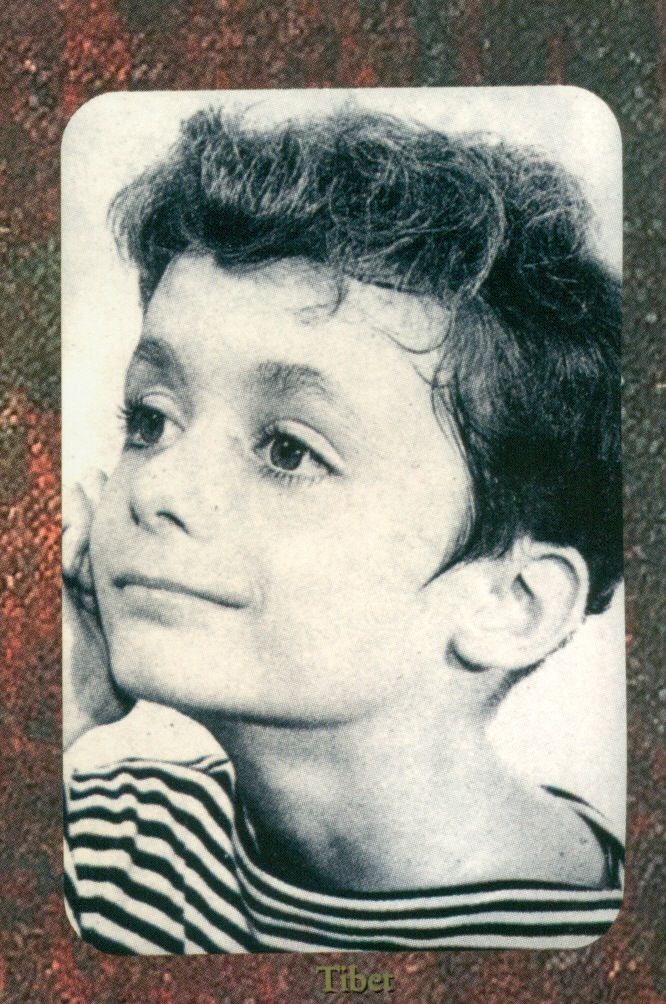
Photo caption: David Tibet at age 6
David Tibet (real name David Michael Bunting) was born in a converted stable in Batu Gajah, Malaysia on March 5th, 1960, to British parents. Tibet lived the first ten years of his life in Malaysia, a time period on which he looks back quite fondly. He would spend a great deal of time visiting various Buddhist, Taoist, and Hindu temples, and around the age of 8 or 9 became fascinated with both the Christian Gospels and the Book of Revelation. This idyllic period ended in 1970, when his parents shipped him back to England and enrolled him in a Yorkshire prep school for boys. It was around this point where Tibet discovered Aleister Crowley, when he picked up a copy of one of Crowley’s novels at an airport in Malaysia (in some accounts the novel in question is Moonchild, though in others it’s Diary of a Drug Fiend). He also became interested in Old Testament Apocrypha and the ghost stories of M.R. James.
His first few years in England were very unhappy. As Tibet related in the aforementioned Terrorizer interview, “When I was in Malaysia, which is where I was born and grew up, I was really happy. But I was sent away to a prep school in England, which was, for me, horrific. Both the teacher and the divinity master were sacked for child abuse, and there were a lot of terrible things happening there. It was happening on a massive scale. I was sent from a place that I really loved into a nightmarish world, with my parents thousands of miles away, and surrounded by hostile and predatory forces.” In 1973, at the age of 13, he graduated from the prep school and was enrolled in another Yorkshire school, this one being a public school (it was also around this time that his parents moved back to England). Tibet began reading the weird fiction of H.P. Lovecraft and Clark Ashton Smith (and also certain French authors like Huysmans and Baudelaire), and also listening to a lot of glam rock music, groups like Iggy Pop and the Stooges, T. Rex, David Bowie, the New York Dolls, and so forth. In the year 1978, he enrolled at Newcastle University, mainly to study politics and history. At the time, he was interested in extreme political movements, both left and right wing.
It was at Newcastle that Tibet discovered the then recently born industrial music scene, when one of his friends exposed him to Throbbing Gristle, namely the song “Dead on Arrival.” By 1980, along with the music of Throbbing Gristle, Tibet was also listening to Leonard Cohen, Rush, Gregorian Chant music, and, more importantly, Whitehouse and Nurse With Wound, two bands he was pen pals with (the first Nurse With Wound album he got was their fourth one, Insect and Individual Silence, whereas the first Whitehouse album he purchased was Total Sex, which was that group‘s second record). Soon he was collecting any album he could get his hands on from alternative record labels like Industrial Records, United Dairies, and the Come Organisation.
In 1981, Tibet left Newcastle and moved to a squat in London, with a vague idea of studying Tibetan. He began writing to John Balance (who at the time was writing a magazine named Stabmental: this was his pre-Coil days) and the two became friends. Tibet mentioned plans to start his own group, an extreme electronic outfit that would combine the noise of a Whitehouse and a Throbbing Gristle with occult esoterica. He also applied to join the Typhonian O.T.O., a magical organization headed by one of Aleister Crowley’s final students, Kenneth Grant, whose books Tibet was a fan of at the time.
In 1982, David Tibet met Genesis P-Orridge, who proceeded to re-name him “David Tibet” (on account of his fascination with Tibetan Buddhism). It was at this period that Tibet also got involved with Psychic TV, and began working as a music journalist for magazines such as Sounds and Flexi-Pop. After a nine month probationary period, he also joined the Typhonian O.T.O. More importantly, in 1982 he finally got around to forming his band Current 93, which at that period in time included himself, John Balance, and Fritz Haaman. They went into the studio one day and recorded a 12” album which came to be known as LAShTAL (however, the album in question wasn’t released until January 1984). The album was the most overtly occult Current 93 work, directly inspired by Nightside of Eden, the fourth book in Kenneth Grant’s Typhonian Trilogies series, published in 1977. In fact, Grant is even thanked in the liner notes. Today, Tibet dismisses LAShTAL as “witless shamanic posturing.” Indeed, his fascination with Crowley and the occult in general was soon to fade way. For awhile, Tibet considered changing the band name (as he got Current 93 from a Crowley term, the 93rd Current, a phrase often employed by Kenneth Grant and his followers: Tibet merely reversed the term). However, in the end he decided to stick with it.
In 1983, Tibet wrote a much celebrated article about the musical cult surrounding Aleister Crowley for the final issue of Flexi-Pop magazine, said article being entitled “Return of the Beast.” When he sent a copy of the article to Grant, Grant wrote back a letter saying that Tibet should have gotten permission from him first before writing the article. Tibet, incensed, cut his ties with the Typhonian O.T.O. Around this same time he also had a falling out with P-Orridge, John Balance, and the rest of the Psychic TV camp, and decided to strike out on his own. His interest in religion, especially eschatological religion, flared up again, and he began to spend hours at the British Library reading up about the Antichrist (it was at this time that he came across the aforementioned Antichrist in the Middle Ages book by Richard Emmerson). Tibet saw the Antichrist as a marginal figure and decided to do an album about him, in much the same way that industrial bands of the time were co-opting the image of serial killers such as Charles Manson or Peter Kurten. In 1983, Tibet also took part in the notorious Equinox musical event, playing a cover of Charles Manson’s “Cease to Exist” under the band name Dogs Blood Order. It was at this event that he first met Steven Stapleton, and the two eventually became good friends.
Towards the end of 1983, Tibet resurrected the name Current 93, despite the fact he had lost interest in Crowley, as has already been noted. He went into the studio to record his first major album, Nature Unveiled. The album’s title came from the name of the final book written by the Marquis de Sade, which was destroyed after his death (the book’s alternate title, The Days at Florbelle, ended up becoming the name of a Whitehouse track on their 1981 album Buchenwald). The first side of the album was recorded in late 1983, while side two was recorded in early 1984. The album was essentially two long tracks, one on each side of the LP: “Ach Golgotha (Maldoror is Dead)” on side one and “The Mystical Body of Christ in Chorazim (The Great in the Small)” on side two. “Maldoror is Dead” was built around a looped sample of Aleister Crowley chanting “Om” and banging on a drum. Tibet described the track to Steven Stapleton as “like a shadow thrown by a candle onto the wall.” The second track, on the other hand, was more along the lines of an apocalyptic mass. In his interview with Tape Delay, Tibet said, “I always liked the idea of a piece of music that, when the world is being destroyed, would be playing on huge speakers all over the world and it would just collapse to this final fanfare. That was my interpretation of what I would like the music to sound like if I had the choice when we all die.”
“The recorded music on this release concerns itself with the son of Perdition- caput reproborum et caput onnium malorum, id est Antichristus- and his imminent arrival on the stage in which shall be played out the conflict in the Last Times.”
-from the liner notes to the LP of Nature Unveiled
That year, Tibet released not only Nature Unveiled but also Dogs Blood Rising, many songs of which had been recorded during the Nature Unveiled sessions (such as “Christus Christus” and “Jesus Wept”). He also began doing live shows, going on a European tour with Nurse With Wound in late 1984. In those days, Current 93 live shows would often last around 15 minutes, and would involve the band playing over cassettes of Gregorian chants and traditional Japanese music being played simultaneously. During one show in Brussels, Tibet brought a metal crucifix onto the stage, which he proceeded to set on fire before smashing it on the ground and kicking it into the audience.
In 1985, Current 93 released their third album, Live at Bar Maldoror, which was not a live album at all but rather a large collage piece composed of samples from the first two Current albums, just mixed-up and reassembled by Stapleton into something new. It was released on Tibet’s own label, Mi-Mort. However, Tibet found himself slowly getting bored with creating long collages of noise and tape loops. He discovered the album Forever Changes by Love and became obsessed with it. He also began reading up on macabre nursery rhymes, the menstrual cycle, and the Moon in general. These obsessions surfaced in the 1986 album In Menstrual Night, which many Current 93 fans consider to be one of the finest of the loops-based albums put forth by the Current. In Menstrual Night also marked the first appearance of Rose McDowall doing vocals on a Current 93 album. Tibet described the album thusly at the time: “In Menstrual Night is based on nightmares, on little girl’s voices, on acid, on wondering where dreams go when they die. it should be listened to at 2:00 in the morning for optimum effect. It’s the work that I’m most happy with so far.”
In 1986, Tibet became fed up with London and moved to Nepal, but returned back after a short while. That year he recorded what he considered his first “pop” tune, the blasphemous “Happy Birthday Pigface Christus,” with guitar by Douglas Pearce. At the time, it was the most musically conventional Current 93 song yet released, and showcased Tibet’s emerging skills as a vocalist. Around the same time, though, he also did an album named Dawn, yet another apocalypse-based album containing two epic-length tape-loop based tracks, this time released on his new label, entitled Maldodor. Ashamed at his laziness (as the album was recorded in a day, and even Stapleton didn‘t want his name attached to the album), Tibet decided the time had come to move into a new musical direction.
1987 was, by all accounts, a strange year for Tibet. He moved into a flat owned by Freya Aswynn and began studying Norse mythology, runes and the Eddas. He was also doing lots of speed cut with acid at this point, which culminated in a bizarre vision of a crucified Noddy. To quote David Tibet:
“It really impressed me, as you would expect. The next day I just went mad for buying Noddy. Before I’d seen him crucified I wasn’t any more interested in him than any other kid who’s read Noddy as a child. I was taking such a huge amount of speed at the time that I had a massive amount of energy, so I just started hovering around and would come back with binliners full of anything Noddy on. Rugs, mugs, jugs, didn’t matter, bought it all, to the extent that I started wandering round London wearing a red Noddy hat with a bell on the end. Which was probably not a good move in terms of fashion… I was very keen on Noddy. For me, Noddy was the total epitome of innocent childhood. What would be the most unsuitable thing you could give to Noddy for a present? I felt probably swastikas. It then became Swastikas for Goddy on some releases because I started thinking that Noddy was- er, I was taking a lot of speed at the time- that Noddy was in fact a Gnostic icon. This was round about the same time I became interested in Punch and Judy and was seriously thinking it might be worth… I mean, I probably wasn’t well at the time mentally, but having decided that Noddy is a gnostic deity, then it’s a small step to thinking that I might as well worship Punch and Judy. Having been obsessed by Christ for so long, and since Noddy had appeared in the sky crucified, and since Christ was God, therefore Noddy was also God, so he was a Goddy. My mind started going into other ramifications- a whole puppet theology.”
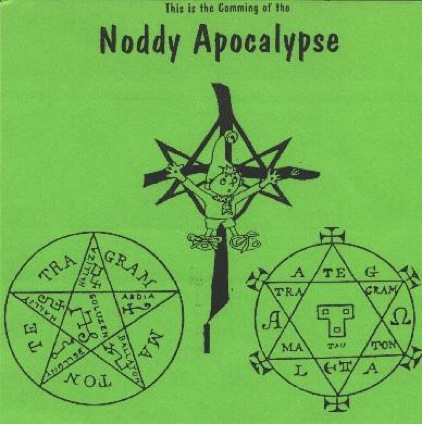
By this point, many people in the British music industry had begun to wonder if Tibet was losing it. This view wasn’t changed with the release of Swastikas for Noddy in 1988 (though it was recorded around September 1987, or maybe 1986, I‘m not sure). At the time, many of England’s underground music community thought of it as a joke, declaring it to sound like Simon and Garfunkel (though it’s worth noting that Tibet had covered two Simon and Garfunkel songs a few years previously, on the final track of Dogs Blood Rising). “I thought they were all fools. They were so stuck in a world where the only thing that mattered were tape loops and 20 minute pieces of music with Manson and Crowley references, a world in which there was no humour. They thought it was a comedy record, whereas I thought it was a record with black humour in it,” Tibet stated. Released during a period in which many industrial bands were moving towards more dance-orientated music, Swastikas for Noddy was an utterly unfashionable album, and perhaps the most conventional sounding Current 93 album up to that point (it was even referred to as “the pop album” or the pop version of In Menstrual Night). Featuring covers of songs like “Since Yesterday” (Strawberry Switchblade) and “This Ain’t the Summer of Love” (Blue Oyster Cult), it also had classic original tracks like the epic “Beausoleil” and “Coal Black Smith.” While working on this album, Tibet discovered music like The Incredible String Band and Shirley Collins, which influenced the new sound.
Shortly after the completion of the Noddy album Current 93 recorded the Imperium album. My thoughts in regards to Imperium are too complex to cover in this summary. I will provide a lengthy analysis of it following the end of this summary.
In 1988, Current 93 continued moving into a folk direction. That year, the band released Christ and the Pale Queens Mighty in Sorrow, probably the band’s most rock-orientated album at that point. It featured songs whose lyrics were taken from the visions of Hildegard of Bingen. That same year the band did perhaps their folksiest album, Earth Covers Earth. With lyrics inspired by not only 17th century metaphysical poets (such as Henry King and John Hall) but also by films like The Wicker Man and albums like Comus’ 1971 album First Utterance, this album is perhaps most famous for its cover art: influenced by the cover of The Incredible String Band’s 1968 album The Hangman’s Beautiful Daughter, it featured a portrait of what was at that point Current 93’s line-up: David Tibet, Tony Wakeford, John Balance, Douglas Pearce, Steven Stapleton, Rose McDowall, and so on.
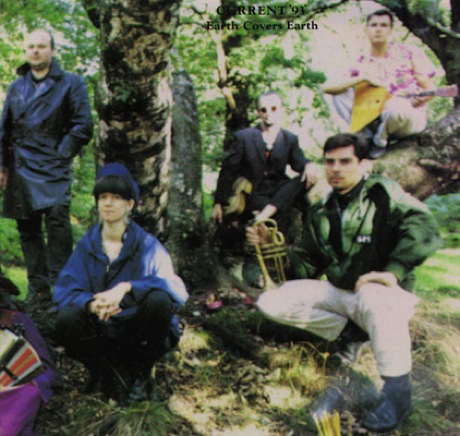
Tibet spent the first half of 1989 living in Japan, where he began to get ideas for future albums. He also started a new label to replace Maldoror: Dutro, which was derived from dur.khrod, a Tibetan word for cemetery, but also symbolizing the nexus between this world and the next. Tibet planned for Dutro to release not only Current 93 albums but also albums by other fringe musicians and outsider artists. Around that same time, he became acquainted with the guitarist Michael Cashmore, who would go on to eventually replace Douglas Pearce as Current 93’s main guitarist.
The next Current 93 album was 1992’s Thunder Perfect Mind. Originally intended to be called The Tale of the Descent of Long Satan and Babylon, at the time Tibet planned for it to be the final Current 93 album, having been unhappy with everything he had recorded prior to that point and desiring to start a new project. The album was at first supposed to be a concept album, a sort of “apocalyptic Tommy.” Instead, it ended up being the first album in which Tibet found himself writing personal lyrics about not only himself but also the people around him. Besides being the most expensive Current 93 album to date, it was also their most bestselling album at that point in time. It was around this period that Tibet began studying Christian theology again, but now he began to think of it as a reality rather than viewing it simply in an academic light. A big influence on his worldview were the writings of Pascal and Kierkegaard. According to Tibet, “I felt that in the shadow of what they were saying, nothing else was important. They pointed out what I now saw as simple truths and simple facts. I felt that we’d all been judged and all found wanting. After reading them things couldn’t be the same again, everything took on a new light, so I’d look at my early material and though I’d be proud of it as experiments in sound and form, I didn’t want to be involved in anything that wasn’t specifically dealing with one’s own soul. The state of the soul became of paramount importance.” Thunder Perfect Mind was also the first Current 93 album to feature an appearance by Shirley Collins, who recorded the album’s spoken word intro. She would play a bigger part in future Current 93 releases, however.

In 1993, Tibet purchased a house in North East London. Inspired by the cat artwork of Louis Wain, who was by this point his favorite artist, Tibet began creating his own artwork, simple drawings using chalk and pastels on paper. He began immersing himself in ghost stories again, re-reading the work of writers such as MR James and Arthur Machen. The financial success of Thunder Perfect Mind enabled Tibet to begin collecting first editions of obscure supernatural fiction writers, and he even started up a new imprint in 1992 named Ghost Story Press, which began publishing deluxe limited editions of obscure ghost story collections. Sadly, I don’t own any of these as many of them are now out-of-print and extremely hard to come by (to say nothing of expensive).
1994 saw the release of a new Current 93 album, Of Ruine Or Some Blazing Star, a record very much inspired by the 17th century composer William Lawes, whose music Tibet was now obsessed with. Unlike previous Current 93 albums which featured a wide variety of musicians, this album was mostly just Tibet, Cashmore and Stapleton. I would like to add here that this album features the track “The Great, Bloody And Bruised Veil of This World” which is, in my humble opinion, Current 93’s finest moment and best individual song.
In the mid 1990’s, Tibet discovered the work of Tiny Tim, who he eventually befriended, although they only met in person once, in 1995. Douglas Pearce objected with Tiny Tim’s views on homosexuality and broke off all ties with Tibet around this point. Tibet released an album of Tim’s music on his Dutro label, and though the two often talked of collaborating, it never came to be, though a few recorded telephone conversations between the two men found their way onto the Current 93 song “When the Great Satanic Glory Faded,” along with the Current 93/Nurse With Wound/Tiny Tim collaboration “Just What Do You Mean By ‘Antichrist’?” Tiny Tim died on November 30th, 1996: Tibet was the last person to speak to him on the phone. A personal disclosure: while I find myself fascinated by many of Tibet’s obsessions, I never got his attraction to Tiny Tim.
In the 1990’s, Tibet also came into contact with the American horror writer Thomas Ligotti. Tibet has stated that he considers Ligotti to be “the greatest living writer.” According to the book England’s Hidden Reverse, when Tibet first came across “The Frolic,” the opening story of Ligotti’s first collection Songs of a Dead Dreamer, he found it so disturbing he couldn’t read the rest of it. Eventually he did finish the book and became a huge fan, to the extent that he ended up sending Ligotti a stack of almost every Current 93 CD, claiming that they shared a vision and that he’d love to collaborate with him. Ligotti agreed with Tibet and the two became friends. In 1998, Dutro released a CD/book entitled In a Foreign Town, In a Foreign Land, with a text by Ligotti and atmospheric, instrumental music by Current 93. They did another album in 2000 entitled I Have a Special Plan For This World, with Tibet reading a text written by Ligotti, somewhat based on a story Ligotti had written entitled “The Bungalow House.” Dutro would also go on to release not only some of Ligotti’s books (such as Death Poems in 2004 and Teatro Grottesco in 2006), but also an album of his own music entitled The Unholy City in 2003. If I’m grateful to Current 93 for anything, it would be for exposing me to the writings of Thomas Ligotti more than anything else.
In 1995 and 1996, Current 93 released a complex trilogy of albums entitled “The Inmost Light Trilogy.” The key record was the second one, 1996’s All The Pretty Little Horses, which featured Nick Cave doing guest vocals on two tracks. In 1998, the band released perhaps their most minimalist and intimate record, the lovely Soft Black Stars, which was mainly just David Tibet’s vocals and Maja Elliott’s piano playing. Incidentally, the phrase “Soft Black Stars” was taken from Thomas Ligotti’s short story “Teatro Grottesco.”
The start of the new millennium was a turbulent time for David. After officially converting to Catholicism, he had to deal first with the death of his father, then a near-death experience of his own. In August of 2000, a stomach complication left him a mere two days from death. Stricken with peritonitis, Tibet had to have emergency surgery performed, where it was discovered that his appendix had gone beyond gangrenous and that he had developed blood poisoning. After the surgery, Tibet was put on morphine and wheeled back into the ward, where he soon found himself in a hallucinatory state. It was here, surrounded by other men who were gravely ill, that Tibet claims to have seen the angel of death come down to the person in the bed next to him in the form of “a shaft of decadent purple light.” As Tibet described the experience in Terrorizer magazine: “It descended as a scarlet purple bolt that came diagonally across the ward. There was no face, but I was aware that it was the angel of death. It landed next to my neighbor, disappeared, and left behind a dark grey cube. It had the nature of a black hole and was sucking in all the energy around. It was made plain to me that this was this person’s psychopomp- the guide of the dead, the entity that guides you to your judgment. This was left for the gentleman that died.”
In the year 2000 Current 93 also released a new album, Sleep Has His House, which was dedicated to the memory of Tibet’s dead father. One of the sadder and more minimalist Current 93 works, its dominant instrument is an Indian harmonium, which makes the album sound almost like something that Nico would have released in her prime.
Around 2002, Tibet became fascinated with the Biblical Coptic language. This current obsession was triggered by a reading of The Gospel of Thomas in which he came across the line “Jesus said, Lift up a stone and I am there. Split the wood and I am there.” Incidentally, this is the same passage that inspired Poppy Z. Brite to look deeper into Christianity, though I believe she first came across it in the horror film Stigmata. Those interested in learning more about David’s Coptic studies should consult the following link: http://www.copticcat.com/davids-coptic-studies.
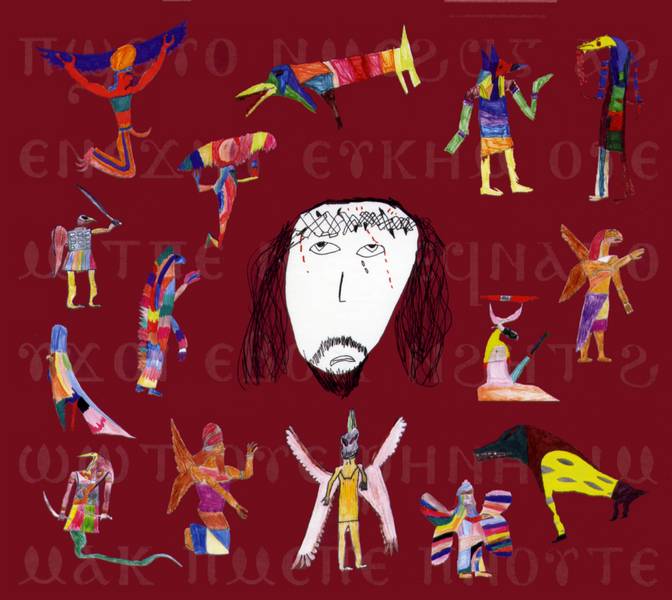
In 2006, Current 93 released its most ambitious album to date, Black Ships Ate The Sky. Four years in the making and subtitled “A Hallucinatory Patripassianist Dream,” the texts written for the album were inspired by an intense dream Tibet had which involved black ships eating the sky in preparation for the arrival of the Antichrist. Tibet described this dream as follows: “I had a dream in which I saw black ships coming across the sky. I saw a black smudge on the extreme right of my ocular horizon, and it jumped, almost like those cartoons where you flick the pages, or when you see old film of an athlete running. It was a really disturbing motion. Eventually I realized that the smudge was made of ships, and as the dream carried on they filled up the entire horizon. Everything they passed they devoured, until all that was left was a corrupted sky. It was made clear that these ships were announcing the coming of the final Caesar, the Antichrist, which pre-empted the last scene before the second coming of Christ.”
In following dreams, Tibet began seeing geometric faces, colors, words and shapes falling into a crack in his head. These dreams also found their way into the lyrics for Black Ships Ate The Sky. One of the most notable aspects of the album is that it features nine different versions of the 1763 Methodist hymn “Idumæa (written by Charles Wesley), each which features vocals by a different artist (the hymn is sung by not only Tibet but also Marc Almond, Bonnie ‘Prince’ Billy, Baby Dee, Antony, Clodagh Simonds, Cosey Fanni Tutti, Pantaleimon, and Shirley Collins). The album was issued in a deluxe digipak packaging, with a 56 page booklet containing liner notes, lyrics, photographs, and other ephemera. It’s my opinion that Black Ships Ate The Sky is still one of Current 93’s most successful projects to date, and the stream of conscious lyrics are simply mind-boggling (my favorite lines including “I want to have lunch with the Umbrella Ladies/ I want to make love with the Umbrella Ladies”).
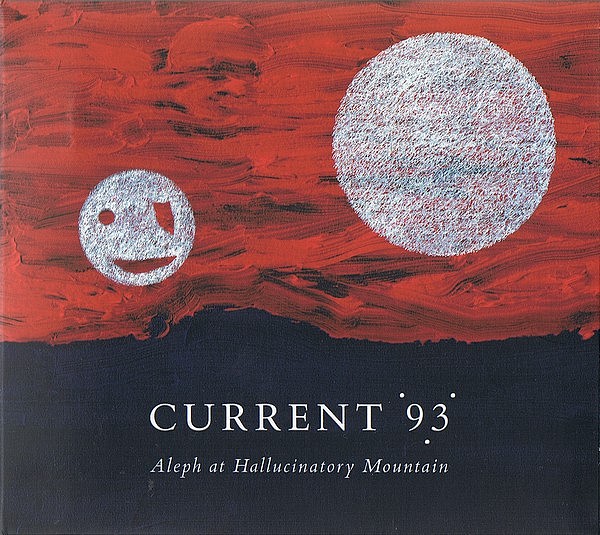
Since the release of Black Ships Ate The Sky Current 93 has released two more major studio albums, Aleph at Hallucinatory Mountain in 2009 and Baalstorm, Sing Omega in 2010. Aleph was very rock-orientated, what with its use of electric guitar, and featured appearances by Andrew W.K. (on bass, piano, vocals, and finger bells), Sasha Grey (on vocals), and Rickie Lee Jones (also on vocals). Baalstorm, Sing Omega, which is the conclusion of the Black Ships Ate The Sky trilogy, has a sound that reminds me more of Current 93’s Inmost Light/1990’s phase, just with more experimental lyrics. It was also one of the first releases for David Tibet’s new record label, Coptic Cat, which replaced Dutro Records sometime in 2009.
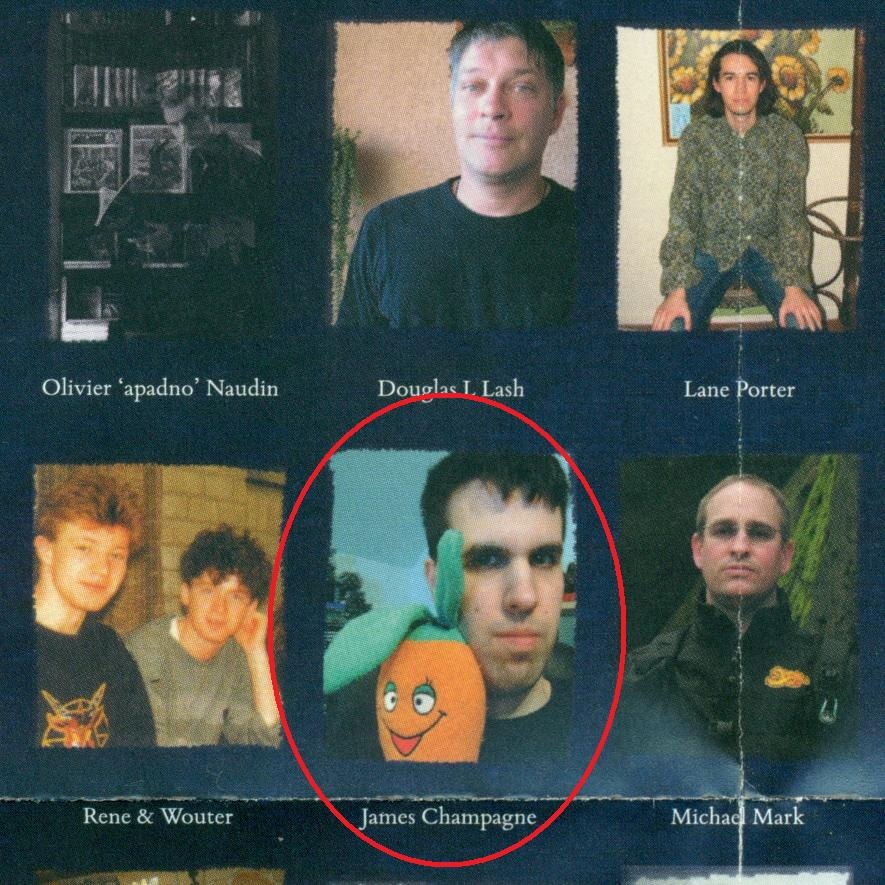
One of the cool things about Aleph at Hallucinatory Mountain was that it had a subscriber’s edition, in which people who subscribed to this edition of the album (and thus help fund its creation) got to have their name and picture included with a poster that came with the album. Needless to say I jumped at this opportunity to be involved, no matter how small, in the rich history of Current 93, and thus my visage may be seen in said poster. I hope this didn’t affect sales negatively in any way!
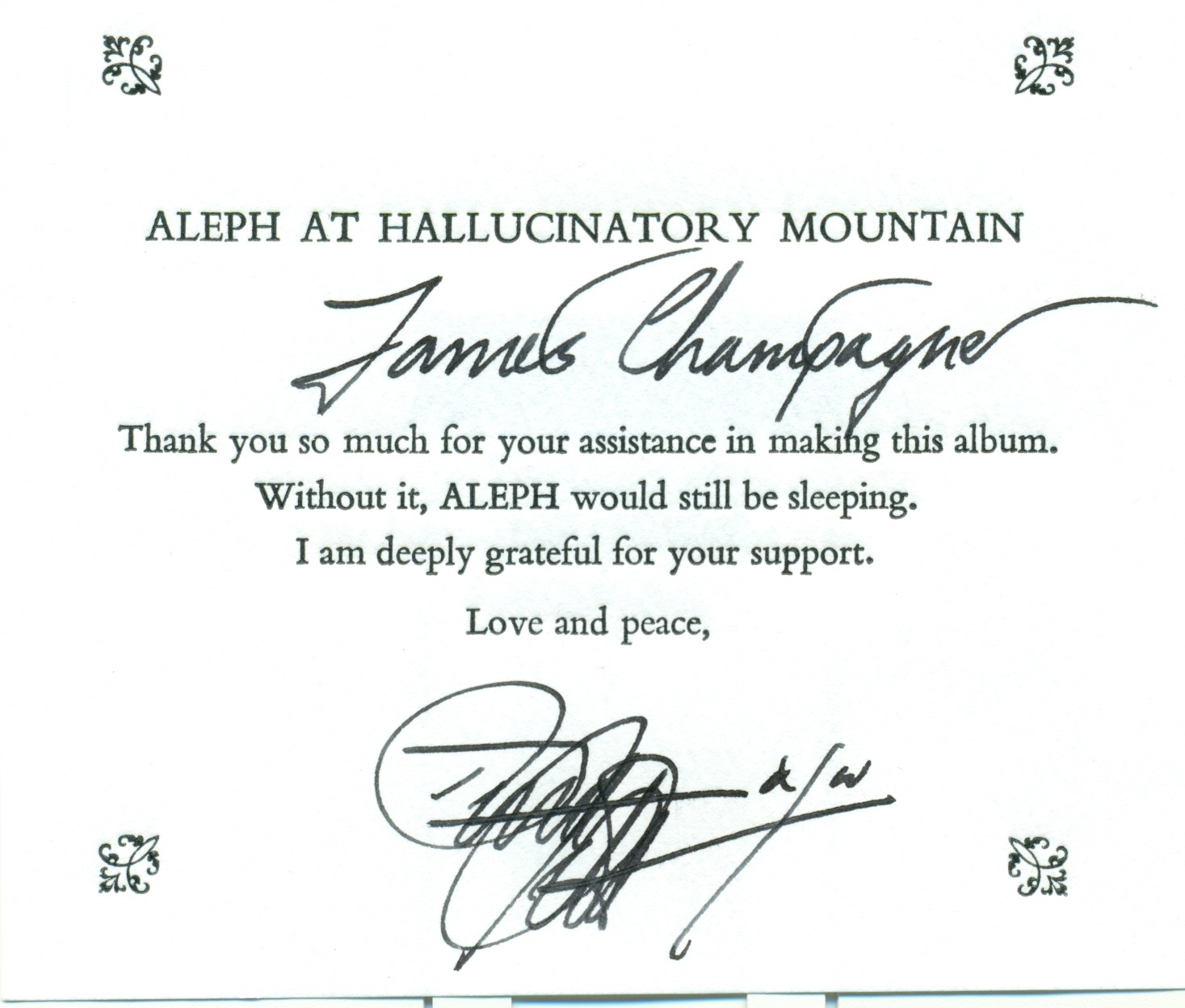
I previously mentioned how collecting Current 93 can be a daunting task due to their exhaustive discography. Indeed, even though I pretty much have all the major Current 93 studio albums on CD there are still a few I’m missing (it kind of shames me that I don’t have Swastikas For Noddy in CD format, though I do have it in MP3 format). It doesn’t help that many of Current 93’s older albums are out-of-print, though Dutro/Coptic Cat has been re-releasing many of the older albums such as Nature Unveiled, Dogs Blood Rising, Live at Bar Maldoror, In Menstrual Night, and Dawn in deluxe editions over the last few years. I really wish they’d re-release both Imperium and Swastikas For Noddy soon, which I assume are next in line!


my Current 93 CD collection
Those interested in exploring the music of Current 93 might want to check out one of their “Greatest Hits” collections first. These are good starting points. To date there have been three of these. The first one was Emblems: The Menstrual Years (Dutro, 1993). This two disk, 28 song set is compiled by both Tibet and Stapleton and covers the years between 1982 to 1992, collecting material from the Nature Unveiled, Dogs Blood Rising, Live at Bar Maldoror, In Menstrual Night, Dawn, Imperium, Swastikas For Noddy, Earth Covers Earth, Christ and the Pale Queens Mighty in Sorrow, Thunder Perfect Mind, and various b-sides, singles and unreleased tracks. Those interested in Current 93’s early sound might be interested in this release, though it’s hard to come by these days. A shame, as the interior artwork is quite nice. The second Current 93 retrospective is entitled Calling on Vanished Faces (Dutro, 1999). This two disk, 30 track set covers the years 1984-1999, with a greater focus on the 1990s material (though it does include “Maldoror is Dead” in its 20+ minute entirety). The easiest Current 93 retrospective to find in stores is Judas As Black Moth: Hallucinatory Patripassianist Song (Sanctuary Records, 2005). This two disk, 32 song set focuses mainly on material from the 1990s and 2000s, with only around 4-5 songs representing the 1980s period. Therefore, ideal for those more interested in the latter day Current 93 material. The CD booklet for this release features some of Tibet’s closest friends and accomplices sharing their thoughts about Current 93, so it’s a pretty nice package.
For the record, my top five favorite Current 93 albums as of June 2010:
1. Imperium
2. Black Ships Ate The Sky
3. Dogs Blood Rising
4. Soft Black Stars
5. Swastikas For Noddy
Although In Menstrual Night and All The Pretty Little Horses are also strong contenders.

David Tibet today
An Exegesis of Imperium
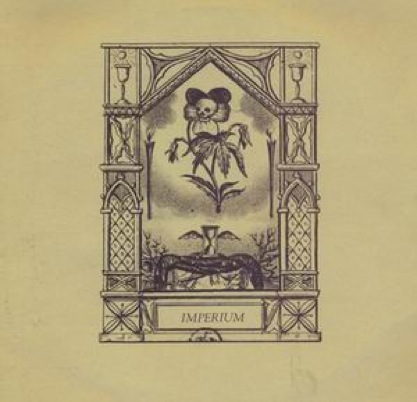
I would now like to talk a little bit about my all-time favorite Current 93 album, Imperium. I forget exactly when it was I first heard this album. It was probably sometime in 2003 or 2004, certainly no later than 2006 (as I mentioned it in my first book, Confusion). However, it wasn’t until 2008 that I became especially obsessed with it.
Part of the appeal of Imperium is its cryptic nature. There’s not a whole lot of information available about this album, and the CD release has no booklet, no liner notes or credits, only a track listing and a quote from the Dhammapada:
“Some die when they are in the womb
Some on the ground where they are born
Some die just as they learn to crawl
And some as they learn to walk
Some die old and some die young
Some in the very prime of life
All people pass in turn
Just like the fall of ripened fruit
As all ripe fruit
Always falls and rots
So all who are born
Are always by their deaths destroyed”
Imperium was released in LP format sometime in 1987, on Tibet’s Maldoror label. Although it was apparently recorded immediately after the completion of the Swastikas For Noddy album (apparently sometime in the Fall of 1987, or maybe 1986), it ended up being released before Noddy (which was, as previously mentioned, released in 1988). The first side of the Imperium LP had 4 tracks, “Imperium I-IV,” while the second side also had 4 tracks, “Be,” “Locust,” “Or,” and “Alone.” When the album was released on CD in 1992, two new tracks were added at the end, “Time Stands Still” (which had previously been released as a split with Nurse With Wound in 1988), and an “Untitled” final track. When the CD was re-released again in 2002, “Time Stands Still” was moved in between “Imperium IV” and “Be,” while the “Untitled” track was sadly dropped altogether for some unknown reason.
For quite a long time, I was confused as to why the two sides of the Imperium album sound so different from each other: in fact, they almost sound like two totally different albums that have been spliced together. Then, I recently came across an old interview with David Tibet from 1987 where, when asked of his future plans, he mentioned something about a CD that would be half Nurse With Wound and half Current 93 entitled Imperium. Which makes sense to me now, seeing as the first side sounds more Nurse With Wound like whereas the second side is more reminiscent of the Noddy style of music that Current 93 was doing at that time.
Although no credits are given with the album, in the 1993 Current 93 magazine Apocalyptic Folk in the Nodding God Unveiled the line-up for the Imperium album consists of David Tibet, Steven Stapleton, Douglas Pearce, and Tony Wakeford. It’s probably a safe guess to say that Stapleton worked on the first side of the LP, while Pearce and Wakeford provided the guitar and bass work for the second side of the album. As for the keyboard work found on the album’s second side, it sounds to my ears like the work of Hilmar Hilmarsson (or HOH), who was working with Tibet quite a bit at that time period.
The name for the album was most likely inspired by Francis Parker Yockey’s 1948 neo-Spenglerian, 600 page book entitled Imperium: The Philosophy of History and Politics. Not only is Yockey credited as an influence on the Curent 93 website at Brainwashed, but I’ve also been informed that Tibet quotes Yockey’s book at the start of “Great Black Time,” the song that occupies side one of the Dawn album.
Many Current 93 fans consider Imperium to be one of the band’s most depressing and melancholic albums. This is probably due to the fact that the lyrics are extremely death-obsessed. The album was recorded during a time in which Tibet was very ill and thought he was dying, and at the time he believed that Imperium would be his final album. This gives both the music and the lyrics an incredible amount of sadness and poignancy, in my opinion. Tibet’s mysterious illness began in the mid 1980s, a few weeks after he gave up speed. One morning while at the Tottenham Court Road tube station he saw all the tiles on the wall begin to blur together, which triggered a massive panic attack. A passer-by managed to get him into a taxi and Tibet returned home, where he laid in bed sweating while being assaulted by waves of panic. Tibet described the feeling as massive waves of electricity that started at his feet and rushed through his body, like an anti-orgasm. He also began suffering from a pins and needle feeling over his entire body, along with complete body dislocation. He started seeing doctors, one of whom suspected Tibet was having a mental breakdown, another who diagnosed it as myalgic encephamyelitis (ME).
These days, Tibet’s psychotherapist suspects that it most likely was a mental breakdown, whereas Tibet thinks it was brought on by “overwork, amphetamine, drink and demons. I think I was being attacked by demons. It’s just like Nietzsche says- if you stare too long into the abyss, the abyss will stare back into you. My interests were dark. I was an arrogant, cynical, interesting and funny person but the balance was wrong. I believe absolutely in the intrinsic existence of Satan and demons and just as often as people like to party with them, they like to party with us.”
So it was in this mental state in which the Imperium album was created. Everyday Douglas Pearce would drive Tibet to the studio, and once there Tibet would lie on the couch and direct proceedings while lying down. Although Tibet’s band mates initially didn’t know he was ill right away, following the completion of the recording Tibet told Tony Wakeford that he thought he might be dying.
The first track of the album, “Imperium I,” has a very medieval sound to it, with Tibet whispering lyrics taken straight out of the Ecclesiastes, such as “Vanity of vanities, all is vanity” (though he also quotes from the Psalms: the very first sound that opens the album is Tibet whispering Psalm 23, “The Lord is my shepherd, I shall not want,” and so on). The second track, “Imperium II,” features a lovely Celtic harp, and is perhaps one of the saddest Current 93 songs ever recorded, with Tibet mournfully quoting passages from the Dhammapada related to death and dying (as seen in the above quote found in the CD case itself). “Imperium III” is a very minimal track, with distorted and slowed-down voices in the background: what these voices are saying, or what their point of origin is, is a mystery I have yet to unravel. Tibet’s vocals are a bit more upfront in this song, and he once again quotes from the Ecclesiastes. The final track off side one, “Imperium IV,” is simply just a strummed acoustic guitar and Tibet singing about the life and death of Jesus, which ends the first side on a pretty note.
Side two opens with “Be,” a very short song (less than a minute) featuring more strummed guitar and what sounds like a child’s toy saying “Nah Nah Nah Nah” over and over again, along with Tibet singing. One of my favorite songs off the album, “Locust,” has a pounding drum beat, acoustic guitar, bass, and really seems the most pop-rock orientated track off the album. It’s also a very catchy song, with Tibet singing “La la la la la la la la” quite a bit at the chorus. “Or,” one of the longest tracks on the album, is set against a sample of the “Horst Wessel Song,” which was the conational anthem of Nazi Germany from 1930 to 1945 (thanks to Michael for providing me with this information), with Tibet reading from the Apocalypse of Thomas in the background (http://www.gnosis.org/library/apcthom.htm). Gradually bass and drums and atonal keyboards are added to the mix, along with Tibet singing original lyrics. It all ends on an apocalyptically noisy note, with Tibet wailing lyrics like “Take me to my dead Christ” and “Carry me from shore to shore.” It never fails to give me chills. The album ends with the track “Alone,” a very quite song that is mainly just Tibet’s voice accompanied by sedate bass and stately keyboards that sound like something off an old Joy Division album. Tibet’s delivery of the lyrics for this song are very sad and resigned, and it’s a great way to end the album, on a very tired and world-weary note.
In regards to the two bonus tracks, “Time Stands Still” sounds like it could have come straight off The Wicker Man soundtrack, while “Untitled” is nothing more than Tibet reading the following Buddhist legend:
“Once the Buddha smiled;
and by the wondrous radiance of that smile
were countless worlds illuminated.
Then came a voice saying:
‘It is not real!
It can not last!’
and the light passed.”
I don’t know how many hours I’ve spent studying this album. On one occasion, I Googled nearly every lyric on the album, line by line, in an attempt to track down all of the literary references. The song that puzzles me the most is “Locust.” I’ll be blunt: I have no idea what the hell the lyrics to this song are about, and if I ever meet David Tibet the first thing I’d ask him would be “What the hell is ‘Locust’ about?” I’ve managed to track down some of the references: the lyrics mention the MR James story “Oh, Whistle and I’ll Come to You, my Lad,” while another lyric is taken straight from the Black Mass scene of J.K. Huysmans’ La-Bas. But why are they there? And what does it all mean?
Imperium was a huge influence on my short story collection Grimoire. At the time I was working on Grimoire, I myself thought I was dying due to my declining health and also feeling like I was having a mental breakdown. I thought it was going to be the final thing I’d ever write, so as a result I would find solace by listening to Imperium over and over again. There are many references to Imperium in Grimoire: to name just a few, I quote a few of the same quotes from the Ecclesiastes and the Dhammapada that Tibet quotes in Imperium, the song “Locust” and “Alone” appears on the book’s “soundtrack,” the final three words of the concluding story are “long drawn cry” which are also the final three words for the song “Alone,” one character mentioned a magical phrase entitled “Be Locust Or Alone,” and the same Buddhist legend recited at the end of the CD release of Imperium is used as one of the concluding quotations of Grimoire. But these are just a few examples: there are many more.
Looking back now, I really do think that Imperium saved me from completely falling apart because I was like, “Well, Tibet thought he was dying yet he still pressed on, and in the end he turned out okay and went on to do further great work.” So that really helped me get through that dark period. Like Tibet, I do think a lot of the problems I’m dealing with today can be traced back to some of the things I got myself involved in during my early to mid twenties. I never practiced black magic or anything but I was obsessed with it and always reading about it, along with obsessing with things like serial killers and sexual perversions and that sort of thing. I do think for some people such immersions can be toxic in a spiritual sense and in some ways with Grimoire I was just trying to exorcise it all out of me, as if I were casting out demons. But I realize I probably sound crazy saying all of this so I’ll stop now by saying that Imperium is my favorite Current 93 album and a source of great inspiration and comfort to me. I certainly rank it in my top ten favorite albums of all-time. It’s definitely a transitional album for the band as it was one of the first Current 93 albums that seemed to portray Christianity in a more serious light, and there are times where I wonder if Tibet’s conversion has anything to do with this illness that he went through. Anyway, if I could only recommend one Current 93 album, it would be Imperium for sure.
Some of Current 93’s menstrual music
Current 93’s debut release, the single “LAShTAL.” In his interview in Tape Delay, Tibet noted that the synthesizer buzz of this song “is at the correct frequency noted in The Grimoires to raise up Malkunofath.” The “Grimoires” he refers to is obviously Kenneth Grant’s Nightside of Eden. According to Grant, the 23rd path behind the Jewish Tree of Life is “under the domain of Malkunofat who lies in the depth of the watery abyss. He may be aroused by a shrill stridulation of his name in the key of ‘G’ sharp (upper register).”
Recent (2008) live version of the 1984 track “Maldoror is Dead.” In his interview in Tape Delay, Tibet said that this song was about a friend who died unpleasantly. In another interview, he claimed that the song was about a baby he had fathered who had been aborted by the mother, a baby he had intended to name “Maldoror.” Hence the meaning of the lyric “Maldoror is Dead.”
Excerpt from the track “Jesus Wept” off the album Dogs Blood Rising. A reference to the Gospel of John, XI:35: “Jesus wept” (the shortest entry in the King James Version of the New Testament).
“Holy Holy Holy (for Dusa).”
The second track off the Imperium album, “Imperium II.” This song takes many of its lyrics from the Dhammapada of the Buddhists.
Live version of “Alone,” the final track off the Imperium album. Simply breathtaking.
The track “Black Flowers, Please” off the album Swastika For Noddy. A good example of the “twisted nursery rhyme” phase of Current 93 (one of my favorite phases, actually).
The track “Beausoleil” off the album Swastikas For Noddy. This song manages to make reference to not only the Manson family but also Kenneth Anger’s Scorpio Rising, The Church of the Final Process, Noddy, the Grateful Dead and the Beatles, plus Christ and the Buddha.
“Panzer Rune,” a remix of the Current 93 song “Casting the Runes.” Perhaps the most overtly “industrial” Current 93 song. I think Steven Stapleton did this remix, actually.
The track “Death of the Corn,” from Current 93’s more folk-orientated period. This song reminds me of The Wicker Man.
“Hooves.” I’m not exactly sure what this song is about, but I think it might revolve around a girl who is either obsessed with horses, or the Devil, or both.
The track “A Sadness Song” off the Thunder Perfect Mind album.
“The Great, Bloody, and Bruised Veil of This World” off the Of Ruine or Some Blazing Starre album. Probably my favorite Current 93 song, it almost never fails to move me to tears. I feel it really captures a vision of a mythical, eternal England, like something William Blake would write about.
“Lucifer Over London.” A song originally released as an EP around 1994 or so, the guitar riff at the start of the song is taken from the Black Sabbath song “Paranoid.” According to Tibet, “That was my statement of how I was so utterly sick of the negativity and foolishness of much of what I’d been interested in and involved with myself. My occult, literary and musical interests. I felt like throwing up, I was so sick of it all. Throwing up all the garbage that had been poisoning my soul.”
“Sad-Go-Round.” A cover of a song originally done by The Groundhogs.
Current 93’s cover of the traditional song “Misery Farm.”
“Calling on Vanished Faces I” off the All The Pretty Little Horses album.
“Mockingbird,” off the Soft Black Stars album.
The first 10 minutes from the song “I Have a Special Plan for This World” (the full song runs to around 22 minutes). Words by Thomas Ligotti.
The opening track off the Black Ships Ate The Sky album: Marc Almond’s version of “Idumæa.” I always thought that Marc Almond was underrated as a vocalist, and this song really shows off his powerful vocal skills.
The title track off Black Ships Ate The Sky. This song is an oddity as it features Tibet playing a musical instrument, in this case, the guitar.
The track “UrShadow” off Aleph at Hallucinatory Mountain.
The Art of David Tibet
David Tibet isn’t just a recording artist: he also does art in other mediums. Around 1993 or so, influenced by the art of Louis Wain, Tibet began creating his own art, simple chalk drawings. His medium tends to be pastel on paper, and many of his drawings end up being used as the art for his albums. His work in this medium is represented by the Isis Gallery, and from Nov. 29th 2008 to January 10th 2009 this gallery held an exhibition of Tibet’s work entitled “Invocation of Hallucinatory Mountain (Some Gnostic Cartoons).” Aside from his chalk and pastel drawings, he also does extremely detailed text pieces in which he writes a word or phrase down over and over again, the words gradually forming shapes. What follows is just a small selection of some of his art.
Birth Canal Blue

Promotional art for the Baalstorm, Sing Omega album
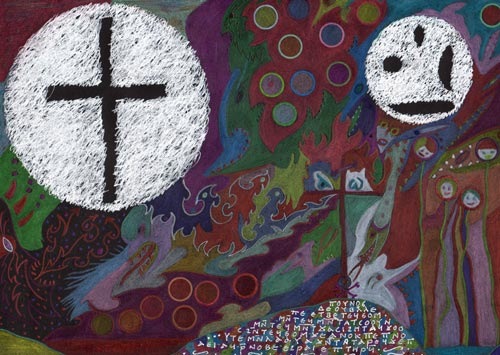
The Singer at Hallucinatory Mountain
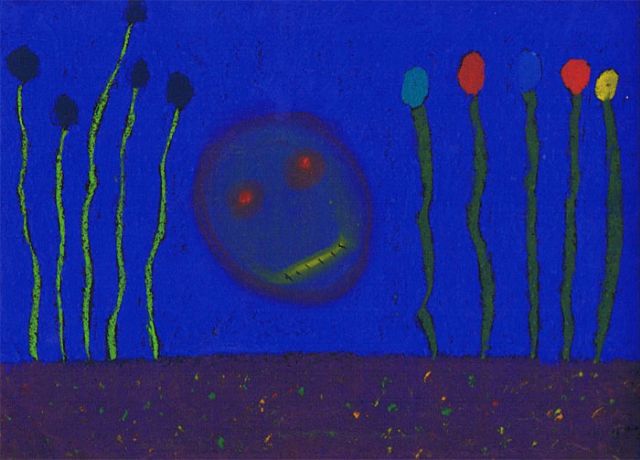
Larkspur and Lazarus

Strip Naked the Great Doxomedon Aion
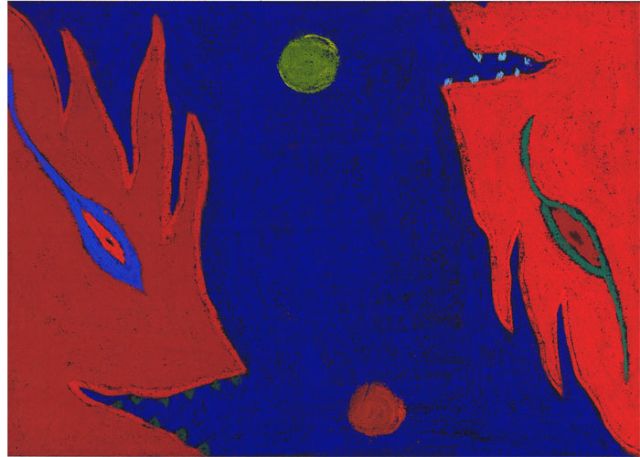
Christ and Two Thieves Ascending
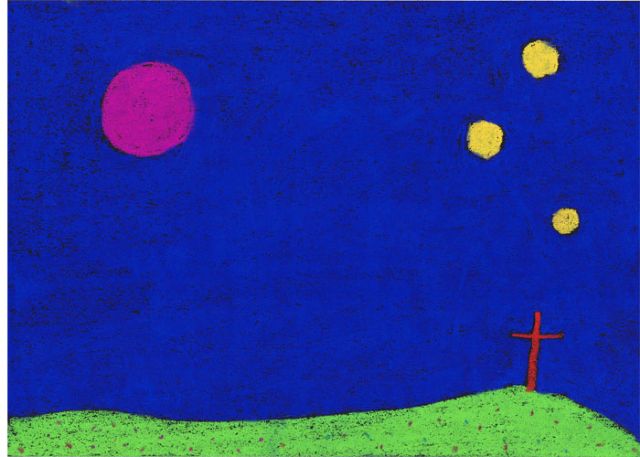
Current 93: Essential Reading
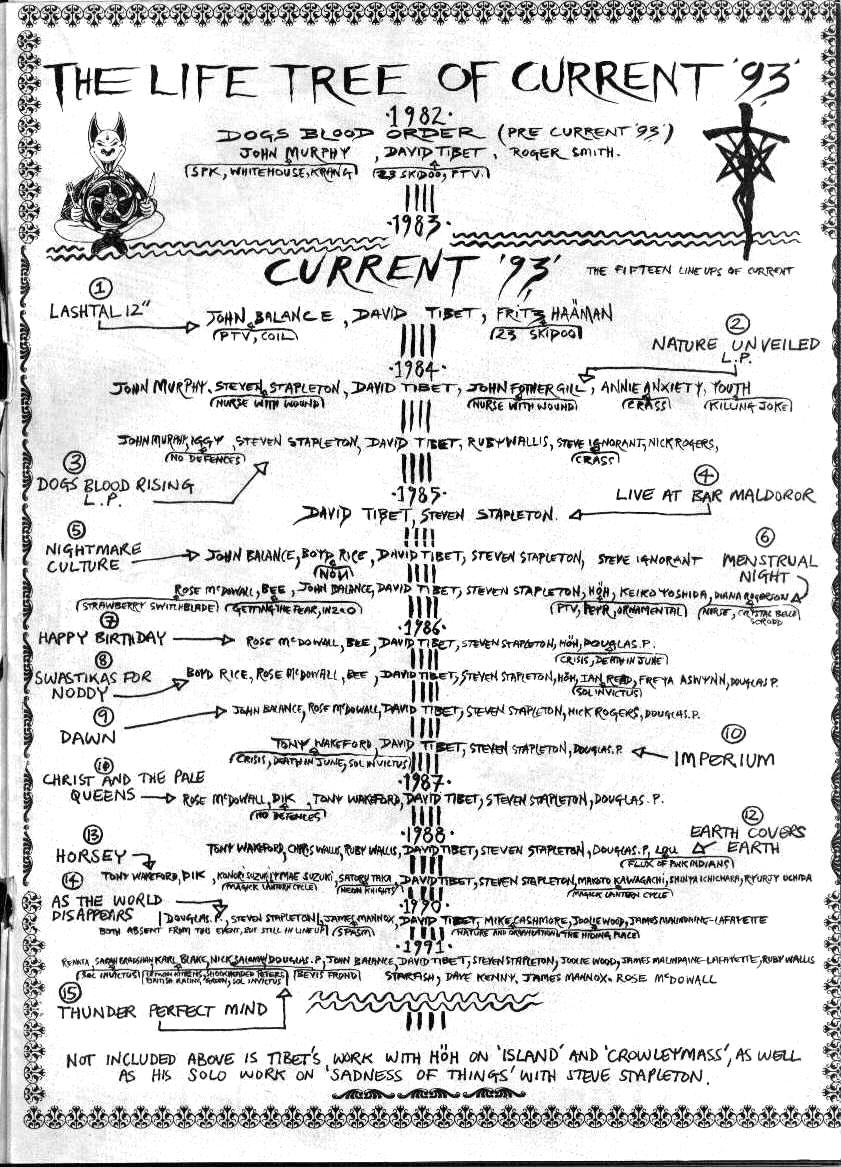
Anyone interested in learning more about Current 93 should really check out David Keenan’s exhaustive book England’s Hidden Reverse (SAF Publishing, 2003). Though out-of-print for years now and quite expensive, it is a fascinating study of the esoteric music scene of England that began in the late 70’s and flourished in the 1980’s. Although Current 93 gets the bulk of Keenan’s attention, it also covers the music of Coil, Nurse With Wound, and, to a lesser extent, bands such as Throbbing Gristle, Psychic TV, and Whitehouse. By far one of my favorite music books. Many of the information found in this day, or various comments I quote from David Tibet, can be found in this book, so I’m really in debt to it. Plus, it has tons of really great pictures. I think it’s one of the most bad-ass books I’ve ever had the pleasure of reading and I can’t sing its praises highly enough.
If it hasn’t been made obvious by this point, Current 93 is a very literary band, and the lyrics often make reference to various books, poems, short stories, or religious texts. I’ve spent a great deal of my time investigating some of these literary references, to the extent that I’ve built a small Current 93 library of my own. What follows is a list of some of the literary sources that have informed some of Current 93’s music over the years. Perhaps needless to say, this list is by no means complete.
Religious/occult texts:
The Bible is perhaps the most important one, as Current 93 albums often include Biblical references in the liner notes of the CD booklets, or sometimes in the spine of the CD Jewel cases. Generally speaking, the New Testament gets referenced the most, mainly the four Gospels and especially the Book of Revelation. Still, Current 93 does make reference to the Old Testament at times, namely the Ecclesiastes, as we have already seen with Imperium.
The Dhammapada (mainly inspired Imperium).
Nightside of Eden (Kenneth Grant) only an inspiration for the LAShTAL single.
The Thunder Perfect Mind (a Gnostic text that inspired the Thunder Perfect Mind album).
The Nag Hammadi Library.
The Apocalypse of Thomas (used as lyrics for the song “Or” off Imperium).
The Cloud of Unknowing
Second Book of Sacred Magic of Abramelin (S.L. Mac Gregor-Mathis)
The Poetic Eddas
The writings of Hildegard of Bingen and Julian of Norwich
Novels:
Maldoror (Comte de Lautreamont) inspiration for many of Current 93’s older songs.
The Decay of the Angel (Yukio Mishima) referenced in Dogs Blood Rising.
Riddley Walker (Russell Hoban) inspired some of the songs on Thunder Perfect Mind.
La-Bas (J.K. Huysmans) a quote from this book appears in the song “Locust.”
Short stories/ Short story collections:
“The Inmost Light” (Arthur Machen) inspired the Inmost Light trilogy.
Anything by MR James, esp. “Oh, Whistle and I’ll Come to you my Lad.”
Tales of the Grotesque (LA Lewis) a story in this one inspired “Lucifer Over London.”
Anything by Count Stenbock, esp. Faust.
“Immortal Bird” (H.R. Wakefield)
“Niemandswasser” (Robert Aickman)
Anything by Thomas Ligotti, especially:
“The Frolic” (from the collection Songs of a Dead Dreamer)
“In a Foreign Town, in a Foreign Land” (from Teatro Grottesco)
“I Have a Special Plan for This World”
“The Bungalow House” (from Teatro Grottesco)
“Teatro Grottesco” (from Teatro Grottesco)
Poetry:
“The Hollow Men” (T.S. Eliot)
Metaphysical poetry of the 17th century (John Hall, Henry King, Andrew Marvell, and so on).
Minor Poets of the Caroline Period (Oxford, 3 volumes)
Non-fiction:
Antichrist in the Middle Ages (Richard K. Emmerson)
The Wise Wound: Menstruation and Everywoman (Penelope Shuttle & Peter Redgrove)
Imperium (Francis Parker Yockey)
Pensees (Blaise Paschal)
Turmoil in the Toy Box (Phil Phillips)
Finally, the first five Noddy books written by Enid Blyton and also the philosophical writings of Søren Aabye Kierkegaard should be mentioned as important influences.
Here’s a list of Tibet’s favorite books (taken from an interview from the early 1990’s… I’m sure it has changed since then):
“My favorite books (in no particular order) are:
COLLECTED GHOST STORIES OF M.R.JAMES
FINNEGANS WAKE by James Joyce
THOUGHTS by Blaise Pascal
Everything by Philip K. Dick (especially UBIK and VALIS)
BILLY AND BETTY by Twiggs Jameson
RIDDLEY WALKER by Russell Hoban
The first 5 NODDY books by Enid Blyton
COLLECTED WORKS of William Blake
Texts from THE NAG HAMMADI LIBRARY
Many tibetan texts, especially from the rNying.ma tradition
Works by Dostoyevsky, Hildegard von Bingen, Lafcadlo Hearn
SHIFTING WORLDS, CHANGING MINDS by Jeremy Hayward
CONFEDERACY OF DUNCES by J.K.Toole”
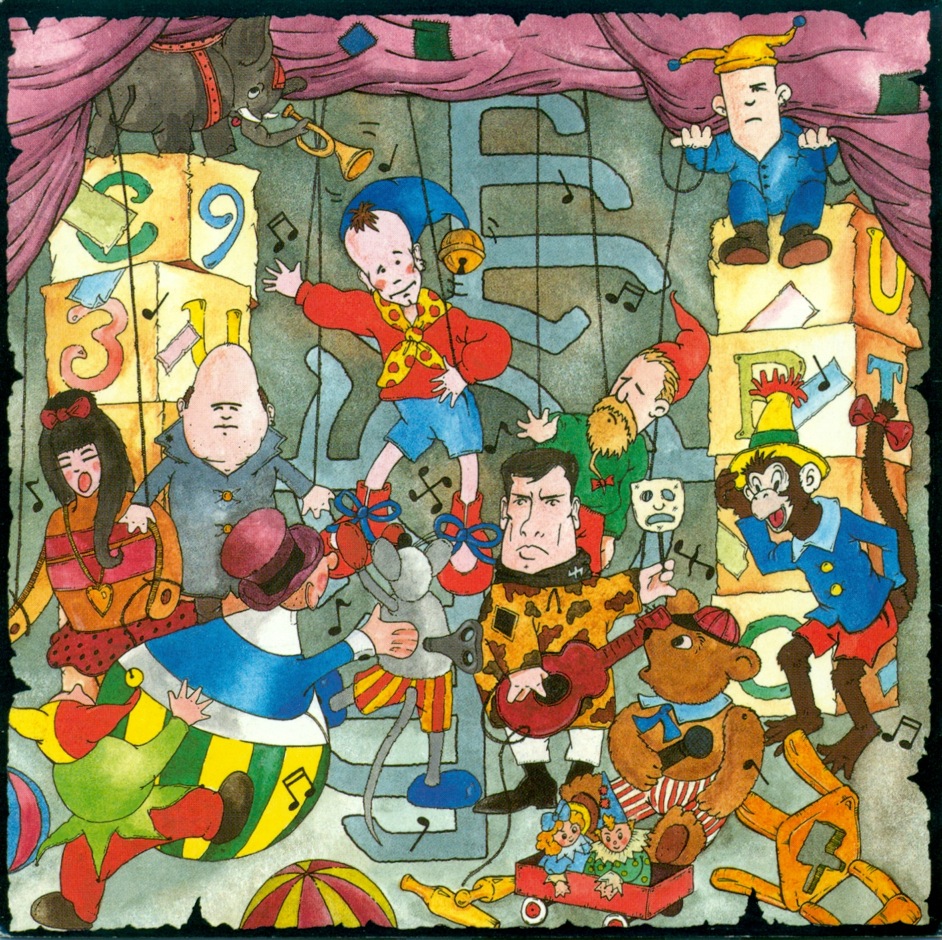
Current 93: links of interest
http://brainwashed.com/c93/
The official website of Current 93.
http://www.copticcat.com/
The official website of Coptic Cat, David Tibet’s record label.
http://www.brainwashed.com/malachai/noddy1.html
The full contents of Current 93’s “Apocalyptic Folk” comic book.
http://www.lashtal.com/flexipop_1983.pdf
David Tibet’s article on Aleister Crowley for the final issue of Flexi-Pop magazine (numbered 666 for the occasion). This article got him in hot water with Kenneth Grant.
http://www.youtube.com/watch?v=-vztk9fqGng
A video of David Tibet’s artistic process.
http://www.youtube.com/watch?v=t7uFFF51uqk&feature;=related
A video of David Tibet talking about his art.
http://www.outsiderart.co.uk/tibet.htm
Some more examples of Tibet’s art.
http://jetfraer.net/Current93/Pri/index-3.html
A collection of early Current 93 interviews (a few of which are in German).
http://www.discogs.com/artist/Current+93
Current 93’s entry at the Discogs website.
* * * *
“To the blessed memory of: John Milton, John Bunyan, Thomas Tallis, Paschal de L’Estocart, Thomas Campion, William Lawes, William Byrd, Frederic Charpentier, MR James, AM Burrage, HR Wakefield, ANL Munby, Edmund Crispin, Blaise Pascal, William Blake, Henry Vauhan, Hildegard of Bingen, Richard Rolle, Walter Hilton, Juliana of Norwich, Sheridan Le Fanu, Frederic Cowles, EG Swain, Christopher Woodforde, William Caldecott, NP Dare, Philip K Dick, Arthur Gray, Robert Aickman, LTC Rolt, RH Malden, Henry Purcell, Nicholas Hawksmoor, Michael Maier, Kenneth Williams, Charles Hawtrey and Jeremy Taylor.”
-from the liner notes of Emblems: The Menstrual Years (1993)
“God is Love.”
-1 John 4:16, one of the Biblical quotes that crops up most often on Current 93 albums.
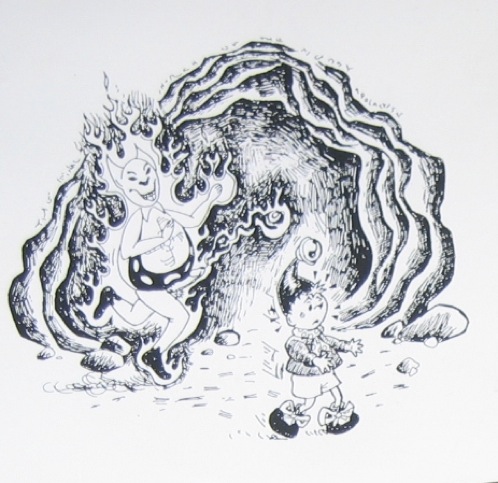
—-
*
p.s. Hey. ** JM, Hi! Knock ’em undead man. All’s well here. xo. ** _Black_Acrylic, When his movies are fun, they really are. Ah! My ears are twitching! Everyone, Hopefully a lot of you have already cottoned to the sonic bliss and muscle toning caused by Ben ‘_Black_Acrylic’ Robinson’s radio program/podcast Play Therapy, and if so, or if not, a new episode is extant and awaiting you. Ben: ‘The new episode of Play Therapy is online here via Tak Tent Radio! Ben ‘Jack Your Body’ Robinson brings you Acid House, Electro, Italo Disco and various other auditory delights.’ Thanks for icing my weekend’s cake, sir. ** David Ehrenstein, Ha ha, the anti-Bresson, weirdly true enough. Oh, we will just have to agree to disagree about the paranormal shows. ** Damien Ark, Hi, Damien. They’re true escapist fun galore in you’re in the mood for such. I’m good, safe, and you make those your goals too, yeah? ** Misanthrope, Killer clip. What rock should be all about or something. I don’t remember you being especially fat but I do remember you being easily winded by NYC’s blocks after blocks. Thank you so much for the link. How fantastic to see that he’s still into very interesting stuff and writing fascinatingly about it. Very, very cool. It’s a pretty rare haunted house that can loosen the bowels. Very unlikely that it would be a maze-type. But what do I know about your comrades bowels? Nothing, gratefully. Maybe fill up on Prune Danishes earlier that evening? 20 possible targets is not bad. Not to mention that Rigby likes it. Yeah, that is meaningful. Guy’s a straight shooter. ** Bill, The fake blood is a nice color, as is the period decor, etc., so there you go, reason-wise. Thank for asking re: my toe. While it is not yet completely right, it does not hurt if I tape it up and walk even decently long distances, and that’s what I call progress. Lucky you on the live streamed concerts front. I had a couple of live in-person concerts scheduled at long last until the curfew murdered them. No, I haven’t seen the new Guy Maddin short! Wow, thank you a huge ton for that. Everyone, Bill has found an entrance to the viewing spot where you can watch Guy Maddin’s new short film “Stump the Guesser”, and Maddin’s a cinema god so I add my high recommendation. Here. Excellent weekend! ** Armando, Hi. Huh. I wonder who LECADIEU is. Sometimes packages end up being waylaid in my building’s concierge’s office, and maybe he’s Lecadieu, so I’ll check with him. Heartburn and nausea definitely suck. Hope they’re departed now. I don’t think I ever believe enough in what’s going on in a film to get creeped out by the content or atmosphere. I’m always as interested in the film’s machinations. I’m only creeped out by a film when I feel like its director is trying to fool me into buying a load of crap. In that case, … it’s been a while. Maybe ‘The Lighthouse’. What has creeped you out, film-wise, recently? ** Steve Erickson, That’s been a theme of paranormal movies going back to before I was alive. Yeah, I just find fake paranormal things super entertaining and fun. Fuck knows why. But millions seem to feel the same. I saw ‘The Chicago 7’. I thought it was like a 90s TV show, so shallow and rote and full of phoney drama, etc. Too bad. It’s a moment in time that could become something actually relevant and intense in the hands of a director who’s actually interested in cinema. ** Okay. This weekend’s continuance of the blog’s Halloween celebration is a back-from-the-dead restoration of one of James ‘Sypha’ Champagne’s monumental, possibly definitive, wholly personal guest-posts, in this case about the Halloween-friendly musical project Current 93. Lots and lots for you to explore and learn and enjoy and so on. Hope you will. See you on Monday.




 Now available in North America
Now available in North America 
I’m happy to be a C93 fan but as a mere layman, their output has always been daunting. Sypha’s legendary post here has served as a guide since it was first posted, and I’m very happy to see it return. Up in Dundee storage I still have their Imperium CD that Sypha did for me somewhere.
The Dundee writing group may have died a death, but that same tutor is about to start a course via Zoom in Flash Fiction that I’m gonna sign up for. It starts 5th November and it might be just the thing for a bleak lockdown winter.
Good to see this massive compendium again for the weekend, Sypha and Dennis. I’m mostly familiar with C93’s first few albums. The split EP Nightmare Culture is probably my favorite of Tibet’s work. Will check out Imperium and Sypha’s other favorites soon.
Hope you enjoy the Maddin short, Dennis. The same festival is also showing the new Bruce LaBruce, but I don’t think that’s your thing, right?
Bill
Dennis, Sypha? Name rings a bell. 😉
Yeah, seems JW is doing his own thing now, and I’m glad for it. I like to see people, especially friends, happy and thriving.
So the Trail of Terror…yeah, it was fun. It was essentially a corn maze and then an Asylum maze. Lots of jump scares. Lots of chasing. The costumes were pretty damn good and so were the actors. I give them props.
One funny thing is how they targeted Kayla, to the point where they’d run past me to chase her. She said that’s typical for her in a haunted house/maze type thing.
Afterward, we went out to eat and had a good time. But here’s the scariest part: seems I forgot to put my mask on walking out the 10 paces to get outside and you would’ve thought I was a mass murderer to the few other people who were in there. Everybody just staring like, “I’m gonna die!” But whatevs, just had a brain fart and everyone else was heading out the door and I booked it. Yikes.
Danish prunes. Nice, hahaha.
Yes, that’s one of the lovely things about my friendship with Rigby, he can tell me when I’m being an ass and I know we still love each other. Same with any writing I do. Dude doesn’t hold back, hahaha. He had some minor critiques, most of which I incorporated because he was…just right. Good to have a friend like that. Joe’s like that too, and we have the same dynamic in our relationship. And oh, hell, you should see the three of us together. It’s quite comical. 😀
I did watch the MC5 clip finally…and loved it. That’s really what music is all about, live music anyway, and to think that was 1970! Great stuff.
Hey Dennis, thanks for resurrecting this one. Trying to remember when this one first even debuted… I’m guessing 2010 as I don’t see their album HoneySuckle Æons (2011) in my picture of my C93 collection. Think since this blog day debuted they did 4 further albums, so Tibet seems to have slowed down… well, he has a lot of other projects I suppose, what with his art and those supernatural anthology collections that he edits now. Oddly enough I’m not as obsessed with the band as I was back in the day, mainly because I feel that they kind of peaked with BLACK SHIPS ATE THE SKY in 2006 and it’s mostly been diminishing returns since then (also, I feel that over the years Tibet’s lyrics have become so cryptic and obtuse that I essentially have no idea what he’s talking/singing about anymore).
Quite a Musical Mulligan Stew this weekend. Merci
Here’s Adam Lambert paying tribute to Cher
Here’s a llittle something I just wrote for the “Los Angeles Review of Books”
Hi besides the name Im not really familiar with the band, so this comes in handy.
I finished Try this weekend and I related as I also had a best friend in school who was H ‘ed out it was like a hospital room at times… she switched to a cuboard filled with boxes of methodone but not before marrying a cop who scored for her. Sigh.
Dennis I been meaning to ask U. In regards to your cycle books, did U ever hesitate concerning your subject matter, specifically in regards to family and equintances, that people who were in your life that not necessarily understood art or literature, that these people ever stood in your way with tackling subjects you were interested in? So far for me I have not really held back.. but sheez im starting to wonder.. i have family that wouldn’t understand… its part of the turf i guess of being an artist. This year was tuff. But I been getting writing done znd still experimenting. I just wish authority will leave the building oneday… I still feel like im being regulated and Im 35!
My favorite Christian rock band!
Early voting started yesterday in New York, and we’ve had 2- and 3-hour lines.
Hoping to avoid that, I applied today for a mail-in ballot. I’m tentatively planning to go vote later in the week, but my back is not physically up to standing in line for hours. I’m gratified that early voting in the US has become such a popular option and that we might get a landslide for Biden.
I feel like I should watch THE TRIAL OF THE CHICAGO 7 at some point, but I expect dull worthiness with some good performances. MOST HAUNTED released a YouTube video promising a new episode soon. That should be more fun, and maybe even more enlightening.
Hey,
I see. Well, I guess I’m lucky enough in the sense that I still can get lost in a film’s world to see it more… (“innocently”?, “naively”? shall we say?) and really just get creeped out or whatever. (Film has never lost any of its “magic” (so to speak) for me, weird (and weird that it was until the third try that I managed to spell “weird” right after writing “wired” and “wierd”) because Literature and Music largely have to this point but never Film and it is Film what I studied in college, lol). I think I think the ‘The Fear Footage’ Films are what I consider to be just the best purely Horror-Film-For-The-Sake-Of-Horror-Films experiences of this ear or whatever? They definitely do creep me out and I get to enjoy them. (Is there a way in which I can get out of this comment???…)
Funny. So you thought the ‘The Lighthouse’ movie was trying to get you to buy a load of crap? Yeah, I wasn’t impressed by that movie’s hype and whatever. Just seemed like a good one to skip, lol. Did you think that about ‘The Blair Witch Project’ back in the day and that’s what actually scared you maybe, lol?
I hope you’ve been able to see what is up about that package.
Feel like rereading ‘Finnegan’s Wake’. Now that is one damn great novel.
I also would like to come up with a post for a guest-curated day here, but I don’t know if I can or am actually able to. Hm.
Peace.